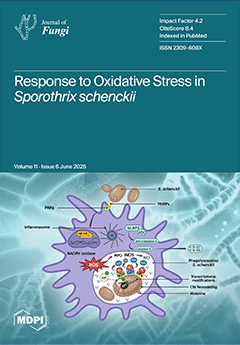In recent years, there has been extensive documentation of pathogenic fungi infecting
Morchella sextelata. However, investigations of microorganisms with antagonistic properties against these pathogens are limited. This study successfully isolated two isolates of the genus
Streptomyces (F16 and F19) from the rhizosphere
[...] Read more.
In recent years, there has been extensive documentation of pathogenic fungi infecting
Morchella sextelata. However, investigations of microorganisms with antagonistic properties against these pathogens are limited. This study successfully isolated two isolates of the genus
Streptomyces (F16 and F19) from the rhizosphere soil of
M. sextelata fruiting bodies, both of which exhibit potent antagonistic activity against
Pestalotiopsis trachicarpicola, the causative agent of
M. sextelata wilt disease. Comprehensive characterization, including physiological–biochemical tests and 16S rDNA sequence analysis, led to the identification of these isolates as
Streptomyces sp. F16 and
Streptomyces sp. F19. Both isolates significantly inhibited
P. trachicarpicola through multiple mechanisms. The volatile compounds produced by these isolates effectively suppressed the conidial germination of
P. trachicarpicola in vitro. Furthermore, fermentation filtrates at various dilutions exhibited pronounced antifungal activity against conidial germination, with
Streptomyces sp. F16 showing 66.93% inhibition at a 50× dilution and
Streptomyces sp. F19 achieving 49.22% inhibition under identical conditions. Field experiments have demonstrated the practical applicability of these antagonists. The topical application of fermentation filtrates (diluted 50×) from both isolates significantly reduced the incidence and severity of disease in
M. sextelata cultivation. Notably, the yield improvements were substantial: fields treated with
Streptomyces sp. F16 produced 299.6 g/m
2, whereas those treated with
Streptomyces sp. F19 yielded 277.65 g/m
2. These yields significantly surpassed those of both the untreated control group (231 g/m
2) and the
P. trachicarpicola-inoculated group (134.93 g/m
2). These findings indicate that the two isolates not only effectively control
P. trachicarpicola but also increase the yield of
M. sextelata.
Full article






